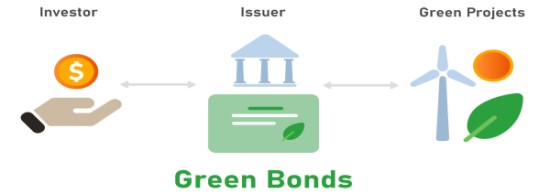How Green Bonds Work?
Stakeholders all over the world are concerned about the irreversible damage being caused to the ecosystem of the earth. There is a common belief amongst people that the natural habitat on planet Earth has been irreversibly damaged. It is true that climate change affects all of us. It is also true that very soon the earth is going to run out of finite natural resources like oil and other fossil fuels. Hence, it is imperative that businesses start investing in projects which are environment-friendly.
However, businessmen all over the world are apprehensive about the possible returns from investing in such green projects. Hence, the concept of Green bonds has been introduced to help organizations manage their move towards sustainability without putting undue pressure on their finances. After all, markets tend to work towards what is cost-effective rather than what is environment-friendly!
There is still considerable ambiguity about the entire life cycle of a green bond. In this article, we will explain the concept of green bonds and how they work in great detail.
What is a Green Bond?
A green bond is primarily a debt instrument. Financially it is not very different from other bonds in the sense that it is a fixed income instrument and pays a coupon payment. However, the bonds are unique in the sense that they are exclusively used to finance green projects. This could be a new green project being built from scratch or an existing project being converted to more environment-friendly norms.
The European Investment Bank pioneered the issuance of green bonds in the year 2007. In the beginning, the issue size was very small. However, over a period of time, more investors and institutions have shown interest in this financing instrument. As a result, there is now a thriving primary and secondary market for these bonds.
Advantages of Green Bonds
Investors across the world are queuing up to buy green bonds. This can be seen from the fact that almost all green bond issues made till date have been oversubscribed.
- The most obvious advantage of green bonds is that it provides finance at relatively lower rates for the projects which are environment-friendly
- Secondly, investors are interested in investing in these projects as a part of their corporate social responsibility. These companies can highlight that they have invested towards improving the ecosystem which generates goodwill for them in the local community
- Lastly, it is easy to keep track of all the green projects being undertaken across the world. This facilitates easy reporting in all the global summits and provides data based on which global leaders can take decisions
- There are numerous tax breaks which are given for making investments in these projects. These tax breaks vary from nation to nation. However, almost all countries that have signed environmental pacts like the Paris Accord tend to give some tax breaks.

The process of Issuing Green Bonds
The first step in the issuance of green bonds is that the project is identified. It is essential that the project is reviewed and certified by a third party. This ensures that the project is indeed based on low carbon emissions. The process is as follows:
- The beneficiary of the bond issue has to clearly identify project(s) which will receive financing from the issuing of green bonds
- The issues also have to ensure that even activities which are not directly related to the project do not contaminate the environment in any way.
- The list of projects then needs to be sent to a third-party verifier. These firms are usually credit rating agencies of global repute. They verify the facts disclosed by the issuer and then certify that the projects are indeed environment-friendly. This certificate is mandatory for the bonds to be called green bonds.
- The issuer has to continuously keep track of the environment impact of the project. Even if the project becomes non-compliant in the middle of execution, the same has to be brought to the notice of the standards board. In the absence of such information, legal action can be taken against the issue for misrepresentation made to investors.
Challenges Pertaining to Green Bonds
Green bonds also have their set of challenges.
- Firstly, even though the issuer is able to obtain finance at a lower rate of interest, they need to make considerable investment upfront. The process of getting these bonds issued is long and tedious. Also, multiple parties have to be involved in the process. Also, all of these parties have to be paid. This offsets the financing benefits for smaller projects. Hence, green bonds can be used cost-effectively only if the underlying project and bond issue is big in size
- Also, there is no clear grading system which defines the “greenness” of a project. What constitutes a green project is open to interpretation. Different agencies have different meanings for these words. The development of green bonds requires a standard set of guidelines and terminologies. Also, it needs a grading system. The bonds which provide more benefit to the environment should get bigger tax breaks and lower financing costs. Only then will companies and investors be encouraged to invest heavily in these projects.
To sum it up, green bonds are an innovative idea to finance eco-friendly projects. However, they are still at a nascent stage and need to be developed further.
| ❮❮ Previous | Next ❯❯ |
 Related Articles
Related Articles
- Fundamental Principles of Accounting
- Cash vs. Accrual Basis of Accounting
- What is Single Entry System
Authorship/Referencing - About the Author(s)

The article is Written and Reviewed by Management Study Guide Content Team. MSG Content Team comprises experienced Faculty Member, Professionals and Subject Matter Experts. We are a ISO 2001:2015 Certified Education Provider. To Know more, click on About Us. The use of this material is free for learning and education purpose. Please reference authorship of content used, including link(s) to ManagementStudyGuide.com and the content page url.